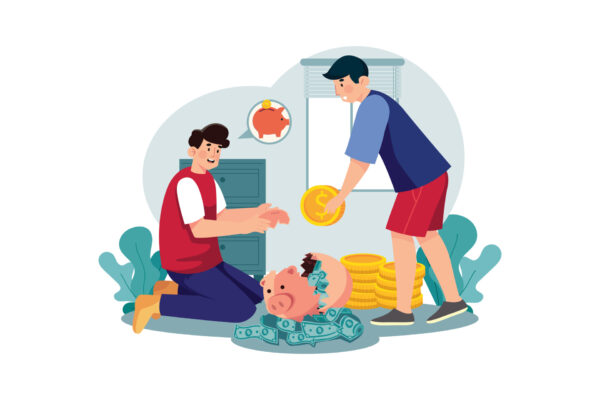Budgeting can sound like a big, grown-up word, but even kids can benefit from learning how to manage money. The 50/30/20 rule is a simple yet effective way to introduce budgeting to children. It’s like a map that helps them know where their money should go.
The idea is to split up money into three parts: half (50%) goes to needs, like school lunches and basic supplies, while 30% is set aside for things they want, such as toys and games. The last slice, 20%, is saved up for the future. Maybe it’s for something big they’ve been dreaming about or just to have savings ready for later.
Sharing examples makes it easier to understand. When kids receive their allowance, they can use half for necessities like art supplies for school projects, a portion for a new toy or a trip to the cinema with friends, and save the rest in a piggy bank or savings account to watch their savings grow.
Learning this simple rule helps kids become better money managers. The earlier they get the hang of handling money, the more confident they’ll be when making financial decisions later in life. It’s not just about saving coins; it’s about understanding the value of every dollar.
Here’s a little transparency: Our website contains affiliate links. This means if you click and make a purchase, we may receive a small commission. Don’t worry, there’s no extra cost to you. It’s a simple way you can support our mission to bring you quality content.
Contents
Breaking Down the Components: Necessities, Wants, and Savings
The 50/30/20 rule serves as a guide, showing kids how to categorize their spending. To break it down a bit more, 50% of their money should go to ‘necessities.’ For kids, necessities can mean school-related costs such as buying textbooks, lunch money, or other essential items. It’s about covering those must-haves that support their daily activities.
Then we get to the fun stuff: 30% of their money is for ‘wants.’ This allows them to indulge in things they enjoy but don’t necessarily need—like the latest action figure, video game, or a day out with friends. It’s important for kids to realize they can enjoy life’s little luxuries, but within limits.
Lastly, 20% goes to savings. This part is crucial and can be thought of as money that gets put away for something big, like a new bike or kept for emergencies. It’s similar to planting a seed and watching it grow into a tree. This part of budgeting teaches patience and forward-thinking.
Understanding these categories helps kids learn the difference between wants and needs—a life lesson that benefits them later on. By setting these spending guidelines early, children develop financial discipline that sticks with them as adults.
Bringing the Budgeting Rule to Life with Real-Life Scenarios
To paint a clear picture of how the 50/30/20 rule works for kids, imagine a child named Jamie who gets $10 a week as an allowance. Jamie decides to follow this budgeting rule diligently. First, $5 goes into covering needs like saving up for a school project or replenishing supplies. These are everyday essentials that keep Jamie prepared and ready.
Next, Jamie allocates $3 to wants. Perhaps there’s a toy Jamie’s been eyeing or a weekend trip to the zoo with friends. This part allows Jamie to enjoy little pleasures guilt-free, knowing that it’s part of the budget.
The remaining $2 goes into savings. Think of this savings pot as Jamie’s way of planning for the future, perhaps for an expensive toy or even a charitable donation to a favorite cause. Jamie learns that little drops eventually fill the bucket and that saving consistently really pays off over time.
In another scenario, consider a family trip where Jamie plays an active part in budgeting. By allocating funds using the 50/30/20 rule, Jamie’s able to balance between covering costs, enjoying outings, and tucking some money away for future adventures.
These examples highlight how real-life application of budgeting turns money management from a duty into a fun, empowering activity. It shows kids that being mindful of money isn’t restrictive—it’s liberating. Helping them relate budgeting to personal stories makes the concept tangible and valuable.
 Section 6: Suggested Kid-Friendly Budgeting Apps or Tools
Section 6: Suggested Kid-Friendly Budgeting Apps or Tools
For older kids or those ready to manage digital money, using apps can make budgeting more interactive and accessible. Here are a few kid-friendly tools that align well with the 50/30/20 rule and help reinforce financial habits:
1. iAllowance
This app allows parents to set up virtual allowances, track chores, and create savings goals. Kids can see how their money is divided and watch their balances grow over time. While it doesn’t strictly follow the 50/30/20 format, it encourages budgeting through goal-setting and tracking.
2. Bankaroo
Created by a kid, for kids, Bankaroo is a virtual bank that helps children manage their allowance. Kids can set goals, track spending, and understand how saving works. Parents can help them divide their allowance into categories that follow the 50/30/20 rule.
3. RoosterMoney
RoosterMoney is a popular choice for families wanting to teach budgeting basics. The app offers separate pots for spending, saving, and giving—making it easy to apply the 50/30/20 method. It’s suitable for both younger kids using a virtual tracker and older ones with real money accounts.
These tools turn budgeting into a hands-on activity and can be a great support for parents introducing money concepts. While supervision is still important, giving kids some control over their financial choices helps build confidence and responsibility.
Transformative Benefits of Early Financial Literacy
Teaching kids about budgeting early sets them up for a lifetime of financial stability. By adopting the 50/30/20 rule, children learn how to prioritize their spending, a foundational skill for managing finances well into adulthood.
Parents have a crucial role to play in this learning process. Encouraging discussions around money and involving kids in family budgeting introduces them to real-world financial scenarios. This guidance nurtures a healthy perspective on finances.
Studies show that kids who engage in financial literacy are more likely to grow into financially responsible adults. These skills translate into making informed decisions on spending, saving, and investing, leading to a sense of economic confidence.
For parents looking to start this educational journey, incorporating budgeting exercises into weekly routines can be highly beneficial. Simple actions, like planning a small budget for a day out or discussing the costs of events, can turn everyday moments into financial lessons.
By equipping children with budgeting skills early on, they’re prepared for future financial responsibilities, whether it’s saving for college, understanding loans, or managing living expenses. This foresight into money management fosters independence and confidence in young minds.


Charles,
I really appreciate how the article demystifies the classic 50‑30‑20 budgeting rule, traditionally taught to adults, and adapts it for children’s allowance or pocket money. By breaking it down into “Needs” (50%), “Wants” (30%), and “Savings/Future” (20%), it gives kids a simple, memorable roadmap for managing their money. This structure aligns with widely-accepted finance advice, yet is still flexible enough to make sense in a child’s world.
What’s particularly clever is the suggested twist: blending generosity into the mix or redefining “needs” for kids, like fun but practical items. Many educators now argue that giving, whether to charity or loved ones, should be part of a healthy financial mindset from early on. Framing saving not just for toys but for future goals, and splitting allowance into meaningful categories, helps children understand value, empathy, and long-term thinking, all while practicing arithmetic and decision-making.
Of course, no budgeting system is flawless. Critics point out that the 50‑30‑20 rule can be rigid, real life isn’t always a neat 50‑30‑20 split, even for adults. For children, whose needs are usually met by parents, simplifying or adjusting percentages is often necessary. The key is fostering habits: regular tracking, discussion about choices, and celebrating milestones, like when their savings reach a goal, really reinforce learning and confidence.
At the end of the day, the goal isn’t perfect dollars-and-cents discipline, it’s healthy money habits and financial awareness from an early age. I’d be curious to know, how would you balance teaching “needs” versus “wants” when kids often blur the lines? And, is there a fun, real-world tool you’d use to help track their allowances and goals? Whether it’s a jar system, a simple spreadsheet, or a parenting app, using a hands-on tool makes the lesson stick, and keeps it engaging rather than preachy.
Kind regards,
Martin
Hi Martin,
Thanks for the thoughtful comment! You really nailed the heart of it — it’s all about building good habits early, not perfect budgeting. I love your point about blending generosity and adjusting the rule to fit a child’s world. As for tools, I’m a big fan of the classic jar method — it’s simple, visual, and fun. Helps make those blurry lines between “wants” and “needs” a little clearer too!
Appreciate you sharing your insights!
– Charles